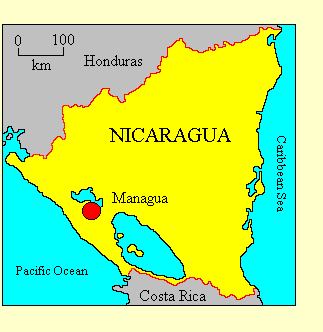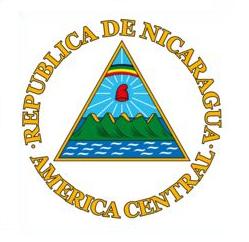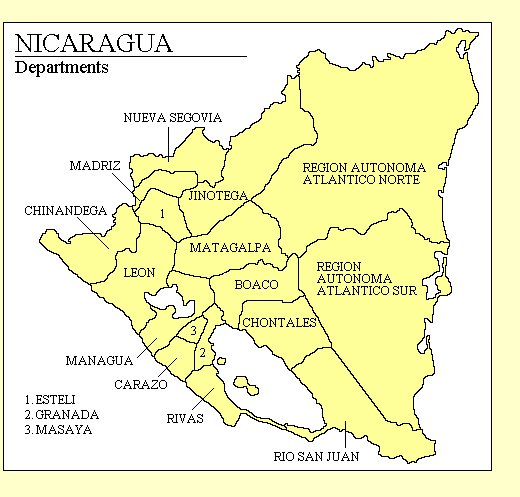

REPUBLIC OF NICARAGUA
• Official name: Republica de Nicaragua (Republic of Nicaragua)
• Location: Central America
• International organisations: Non-Aligned Movement, Organisation of American States,
United Nations, World Trade Organisation
• Borders: Costa Rica, Honduras
• Coastline: Caribbean Sea, Pacific Ocean
• Land area: 129,494 Km2
• Population: 5,900,000
• Annual GDP (PPP) per capita: US$2,800 (2009 CIA estimate). World ranking: 137. Nicaragua is the poorest
country in Central America, and in Spanish-speaking America.
• Ethnicity: Two-thirds of the population are of Mestizo (mixed Amerindian and
European) descent. About 20% are of European (mainly Spanish) descent, and
about 10% are of African descent. There are small Amerindian minorities on the east
coast.
• Languages: Spanish is the official language and is almost universally used.
English and Amerindian languages are used in some east coast communities.
• Religion: Catholic Christian 85%, Protestant Christian 10%.
• Form of government: Presidential democratic republic. Nicaragua is divided into
15 Departments and two autonomous regions.

• Capital: Managua
• Constitution: The
Constitution of the Republic of Nicaragua came into effect on 9 January 1987. It
was substantially amended in 1995.
• Head of state: The President, elected by direct universal suffrage for a
five-year term.
• Head of government: The President, who appoints the Cabinet.
• Legislature: Nicaragua has a unicameral legislature, the
National Assembly (Asamblea Nacional),
which has 93 members, 90 elected for six-year terms by proportional representation
and three who are members by virtue of having been presidential candidates.
• Electoral authority: The Supreme Electoral Council
administers national elections.
• Freedom House 2011 rating: Political Rights 4, Civil Liberties 4
• Transparency International Corruption Index: 25% (127 of 178 countries rated)
• Reporters Without Borders Press Freedom 2010 Index: 77.7% (83 of 178 countries rated)
• Heritage Foundation Economic Freedom 2010 Index: 58.8% (98 of 178 countries rated)
Political history
Nicaragua was brought under Spanish rule in the early 15th century and became part of
the captaincy-general of Guatemala. In 1821 the region became
independent when Spanish rule ended, and Nicaragua became part of the United Provinces
of Central America. In 1838 the federation was dissolved and Nicaragua became
independent. Like the other Central American states, Nicaragua was ruled through the
19th century by a small European minority, and there were frequent revolutions and
struggles between Liberals and Conservatives.
These conflicts led to American occupation between 1912 and 1925. Left-wing guerillas
led by Augusto Sandino continued resistance until 1928. In that year Sandino agreed
to a peace treaty with General Anastasio Somoza Garcia, but in 1934 Sandino was
assassinated and Somoza made himself dictator.

Somoza ruled directly or indirectly with American patronage (it was Somoza of
whom Franklin D Roosevelt said, "He may be a son of a bitch, but he's our son of a
bitch.") until his assassination in 1956, and was
succeeded by his son Luis Somoza Debayle. In 1967 Luis was in turn succeeded by his brother
Anastasio Somoza Debayle. In 1978 a revolt against Somoza's rule broke out, and in 1979
the dictator fled and the Sandinist National
Liberation Front (FSLN) came to power led by
Daniel Ortega Saavedra, who became President.
The new regime at first enjoyed broad
support, but the FSLN's evident intent to create a communist state led to armed
opposition (known as the Contras), armed and supported by the United States. Civil war raged
until 1990, when there was a ceasefire and elections, in which Ortega was defeated
by Violeta Barrios de Chamorro.
Nicaraguan politics was dominated from 1990 to 2006 by the conservative Constitutional
Liberal Party (PLC), which won three successive presidential elections. In 2005 the party split
when opponents of the corrupt PLC President Arnaldo Aleman formed the Nicaraguan Liberal Alliance
(ALN). This allowed Ortega to regain the presidency at the 2006 elections with 38% of the vote.
The FSLN gained control of Congress by forming an alliance with the PLC, whose leader
Aleman was released from prison. Since then the FSLN, which despite a rhetorical commitment to
democracy is still an authoritarian marxist party, has sought to re-establish its control
over the state administration, stifle opposition and entrench itself in power.
Freedom House's 2011
report on Nicaragua
says: "Nicaragua is an electoral democracy... Despite allegations of fraud and concerns over the CSE's impartiality,
the 2006 presidential and legislative elections were regarded as free and fair by the international community...
The political and civic climate is affected by corruption, political pacts, violence, and drug-related crime.
Corruption cases against opposition figures are often criticised for being politically motivated...
The constitution calls for a free press but allows some censorship... The press has faced increased political and
judicial harassment since 2007, as the Ortega administration engages in systematic efforts to obstruct and discredit
critics in the media... Freedoms of assembly and association are recognised by law, but their observance in practice
has come under mounting pressure... Although nongovernmental organisations (NGOs) are active and operate freely,
they have faced harassment in recent years, and the emergence of the CPCs has weakened their influence. The FSLN controls
many of the country's labor unions, and the legal rights of non-FSLN unions are not fully guaranteed...
The judiciary remains dominated by FSLN and PLC appointees, and the Supreme Court is a largely politicised body
controlled by Sandinista judges. The court system also suffers from corruption, long delays, a large backlog of cases,
and a severe shortage of public defenders."
Updated November 2011
|


